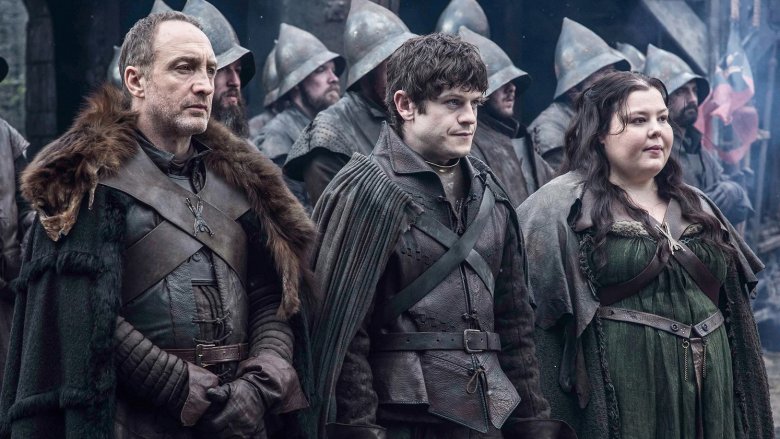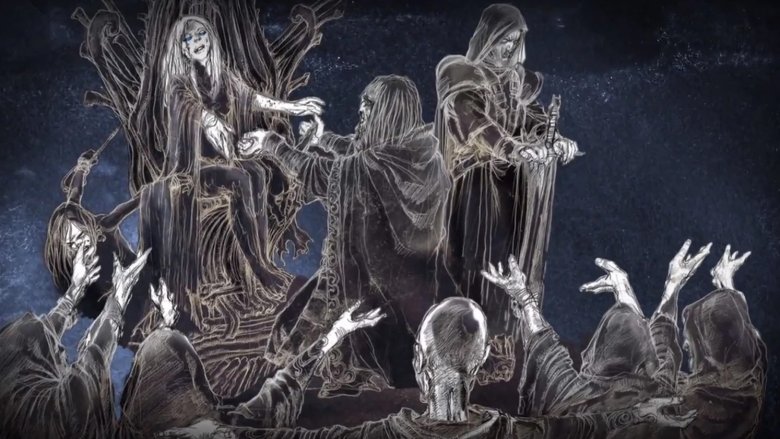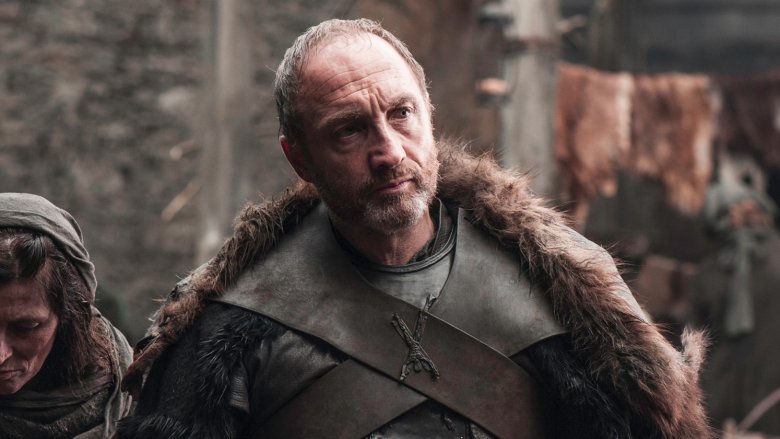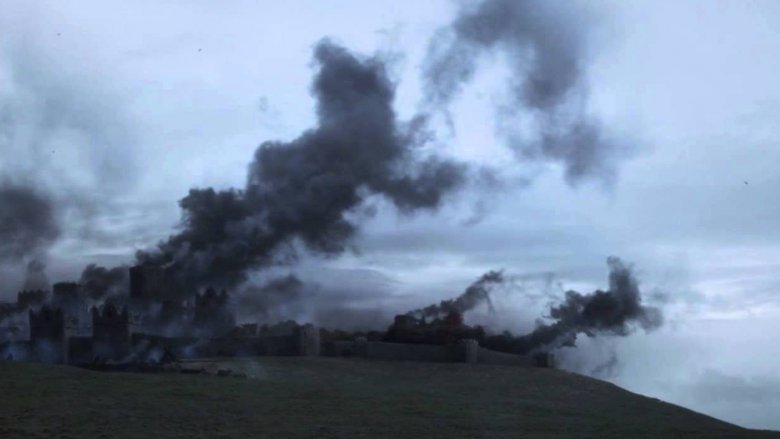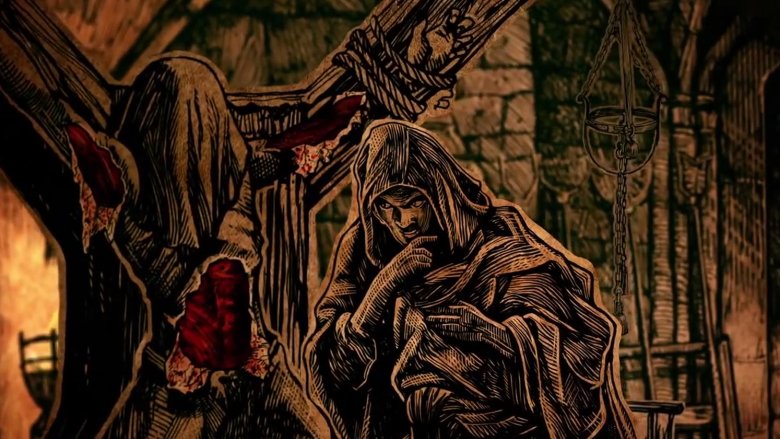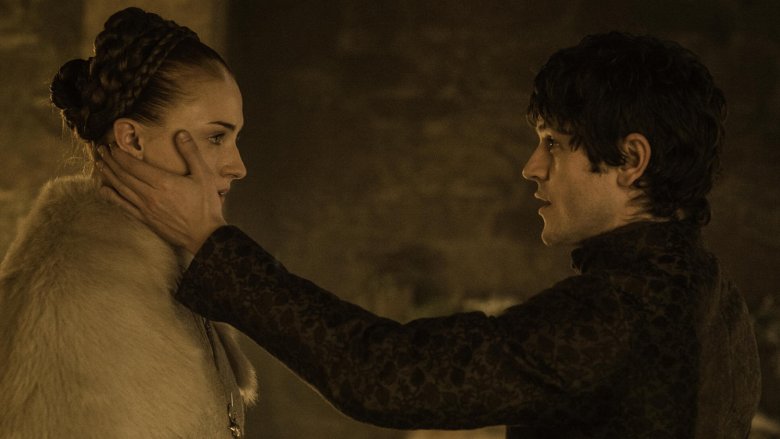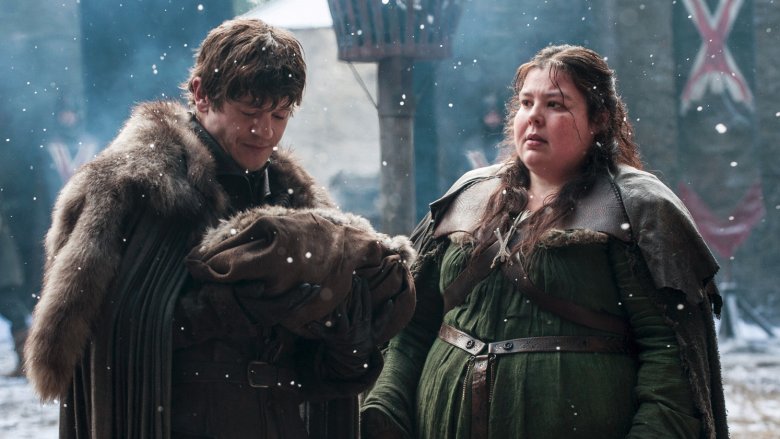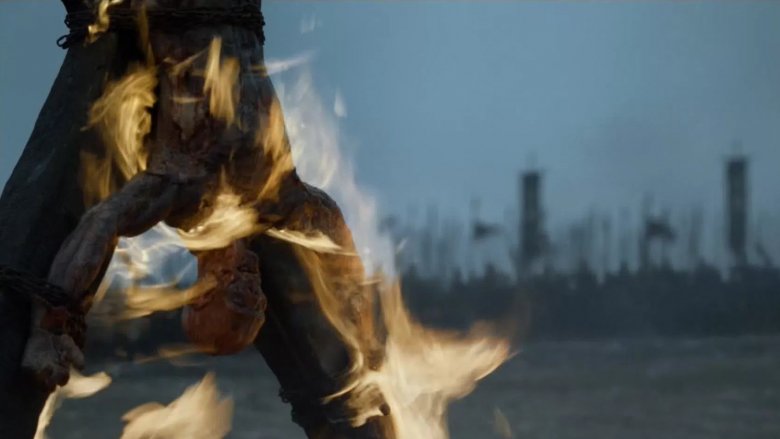The Untold Truth Of The Boltons
Although Lord Roose Bolton and his bastard son Ramsay were both killed off in season six on HBO's hit series Game of Thrones, just take a look at any fan site and you'll find that the spirit of the Dreadfort is still strong among fans of House Bolton. After all, both Roose and Ramsay are still alive and well in George R.R. Martin's books, and as of A Dance With Dragons, they are still in a very strong position as they hold Winterfell against Stannis' advancing army.
While houses with long and noble histories have been snuffed out in an instant before, House Bolton's history is longer, bloodier, and more cunning than most. We've compiled some of that bloody history here for you—some of which might be a surprise to even the most devoted Flayed Man fanatics.
The Night's King
If you're a show-only Game of Thrones fan, you may be wondering what the Night King has to do with the Boltons. Well—nothing, actually. While the leader of the White Walkers is a character invented for the show, there is a character from the world invented by George R.R. Martin called the Night's King—and he may have quite a bit to do with House Bolton.
According to Westerosi legends, thousands of years ago (not long after the Wall was first built), the thirteenth Lord Commander of the Night's Watch fell from grace after he was seduced by a woman "with skin as white as the moon and eyes like blue stars." He abandoned his command and the Night's Watch oaths, laying with her and giving her his seed and his soul, even though "her skin was cold as ice." Her description sounds eerily similar to the White Walkers, even though we have seen no other evidence that female Others exist.
This former Lord Commander brought her back to the Nightfort, where they ruled together as the Night's King and his "Corpse Queen" for thirteen years. During that time, they committed horrible acts of murder, cannibalism, and even sacrificed peasants and men of the Night's Watch to the White Walkers. Finally, Joramun (King-Beyond-the-Wall) and Brandon "the Breaker" Stark (King of Winter) joined forces to cast down the Night's King and retake the Nightfort. Although his birth name was removed from all the records, there are many in the North who claim the Night's King was originally a Bolton.
Immortal blood
Although actor Michael McElhatton did an excellent job portraying Lord Roose Bolton's personality on the show, he doesn't much resemble the book character—which might make this a little hard to swallow for show-only fans. In the books, Roose has pale and pallid skin, an ageless face that is smooth and completely wrinkle-free, and a hairless body and face. His eyes are as pale as chips of ice, "like two white moons." Roose also has several eccentric personality quirks—like his whispery voice, fondness for rare meat, and his habit of having leeches applied to his body to "purge himself of bad blood."
These peculiarities have led some fans to believe that Roose may actually be an immortal being akin to a vampire or a White Walker—perhaps even the child of the Night's King and his Corpse Bride. The theory claims that House Bolton's fondness for flaying their enemies supports this theory—by using skinning in a ritual similar to the methods of the Faceless Men. Allegedly, the current "Lord Bolton" has actually been alive for a thousand years or more, periodically "shedding his skin" to avoid suspicion—taking up a "new" identity by flaying and stealing the skin of one of his adult descendants.
This could explain why Roose acknowledged his bastard Ramsay—he has the same eye-color, which makes him a good potential replacement "skin" in the future. Ramsay is now the only potential replacement identity available—which could be why Roose puts up with his sociopathic antics, and works to have him legitimized by Tommen—so there will be no issue with Ramsay inheriting the Dreadfort after Roose finally "dies."
Burning Winterfell
When Ramsay Snow sacked and burned Winterfell in A Clash of Kings, it was a shocking moment that seemed to make no real strategic sense. It seems even Ramsay wasn't willing to own the decision to burn the fortress—because he later told his father that the castle's destruction had happened at the hands of the Ironborn. But in all actuality, Roose might not have objected too strongly if Ramsay had admitted doing the deed. Ramsay was just following in the footsteps of past Bolton lords. Ramsay's sack of Winterfell was not the first time the castle had been burned. In fact, we know from the books that Winterfell has been burned at least three times before—twice at the hands of the Boltons.
Long before Aegon the Conqueror forged the Seven Kingdoms into one, and even before the Andals left Essos to invade the western continent, the Starks and the Boltons ruled as Kings of their own realms in the North. And for most of their recorded history, the Starks and the Boltons were mortal enemies. King Royce II was the first Bolton we know of who burned Winterfell to the ground, and more than three hundred years later, his namesake Royce IV did it again.
It's very possible there have been even more Bolton burnings that have gone unrecorded; both Royce II and Royce IV lived before the Andal invasion—which happened some four thousand years ago. The oldest part of today's Winterfell (except the crypts) is the abandoned First Keep—where Bran spied on Jaime and Cersei—which was built some time after the Andals invaded.
Red Kings
The Boltons—like the Starks—used to be Kings in their own right. They ruled a huge section of the North, stretching eastward from what is now Manderly land, all the way to the Last River, now ruled by the Umbers. In those days, the Boltons styled themselves as the "Red Kings," and they held a bloody sway over the area from the Dreadfort.
The Boltons were known for flaying their enemies alive; they took a flayed man for their sigil, and were said to have a secret room beneath the Dreadfort, which held the skins of their most prominent victims. King Royce IV Bolton even had the nickname "Redarm" because he frequently tore out the entrails of his prisoners with his bare hands. No doubt many Stark Kings and lordlings died a horrible death within the Dreadfort, and many Stark skins ended up worn as cloaks or carried as banners by the Red Kings.
The Bolton rule as Red Kings came to an end when the Andals invaded. The last true Bolton King, Rogar knew he could not face the Andals alone and so bent the knee—sending his sons to the Starks as hostages and giving up his crown. The Boltons have rebelled against the Starks many times since then; their most recent rebellion was put down around a thousand years ago—and it may have been young Karlon Stark that ended it. As a reward, Karlon was later given former Bolton lands to establish his own seat, called Karhold, and his descendants took the name Karstark.
Ramsay's first wife
You're undoubtedly familiar with the events surrounding Ramsay Bolton's horrific wedding night to Sansa Stark on the show (Jeyne Poole impersonating Arya Stark in the books), but did you know that Ramsay had been married before? That's right—Ramsay was a widower when he came to his second marriage bed, which followed the death of his first wife, Lady Donella Hornwood. House Hornwood sent its men south with Robb Stark during the War of the Five Kings, and unfortunately both Lord Halys and his son Daryn were slain during battles in the Riverlands. This left House Hornwood without a male heir, and Ramsay Bolton (then Snow) saw an opportunity to strike.
He took a force of Bolton men and kidnapped Lady Donella Hornwood as she returned home from a feast, slaying her guards and then forcing the aged Lady Donella Hornwood to marry him. He later brutally raped Donella and forced her to sign a proclamation that made him the Lord of the Hornwood. After receiving the document, he had her locked up in a tower room and left her there without food. While a young woman may have been able to survive such treatment for a couple of weeks, Donella was in her 60s, and didn't stand a chance. When the room is later opened, Donella is dead—with her fingers mostly chewed off and dried blood smeared around her mouth.
The good son
Because he was never mentioned on the show, you might be unaware that Ramsay actually had an older half-brother—Lord Roose Bolton's first trueborn son, Domeric. The infant brother Ramsay kills on the show was actually Roose's second trueborn son. In stark contrast to the sadistic Ramsay, Domeric was well-mannered, educated, quiet, athletic, and cultured. Much like Rhaegar Targaryen, Domeric enjoyed playing the harp, and he was also known to be quite good on horseback, as "none could outrace him," according to Roose. Roose's previous wives had given birth to other trueborn children, but only Domeric had survived past infancy.
Ramsay was born a few years after Domeric, and while Roose didn't openly acknowledge him until recently, it wasn't a particularly well-guarded secret that he was a bastard of Lord Bolton. In 297 AC, Domeric returned from squiring in the Vale, and decided to seek out his half-brother so as to have some companionship. Roose told Domeric not to, but Domeric wouldn't listen, and he eventually found Ramsay at the mill where he lived with his mother.
Shortly after meeting his bastard brother, Domeric fell ill and died of "a sickness of the bowels," but Roose later confides to Theon Greyjoy that he believes Ramsay poisoned Domeric to eliminate him as a rival. With no other heirs remaining to him, Roose was forced to bring Ramsay to the Dreadfort and formally acknowledge him as his son.
The Pink Pavilion
While the Boltons and the Starks more frequently warred with each other during their thousands of years of enmity, they have occasionally allied together to face a common foe. In one such occasion of Bolton-Stark peace, their cause was much less noble. Some 2,000 years ago, the houses joined their forces to invade a small group of islands called The Three Sisters—which lay in the long bay south of White Harbor and north of the Mountains of the Moon. If you speak to any Sisterman today about the invasion—which led to a thousand years of war between the North and the Vale—they'll grimly tell you tales of what they call the "Rape of the Three Sisters," and the various depredations that the Northmen inflicted upon the residents of the isles.
According to these tales, the northern forces of Starks and Boltons committed horrendous atrocities during their invasion. They allegedly murdered children and cooked them in pots, disemboweled men alive and then wound their intestines around spits, and even executed three thousand Sistermen warriors in a single day at a location now known as "Headsman's Mount."
Perhaps the most chilling of these anecdotes is attributed to Belthasar Bolton, who was Lord of the Dreadfort during the invasion. The Sistermen claim that Belthasar flayed over a hundred men of the islands alive, and then had their skins sewn into a grisly tent for himself—which became known as his "Pink Pavilion." None of the Northern accounts of the war mention any of these atrocities, but as they say, history is written by the victors.
